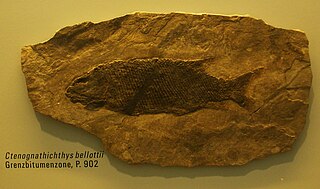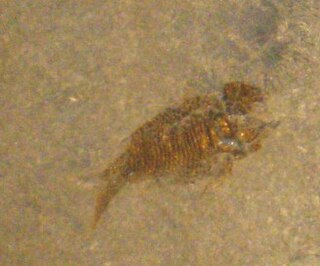
The Amiiformes order of fish has only two extant species, the bowfins: Amia calva and Amia ocellicauda, the latter recognized as a separate species in 2022. These Amiiformes are found in the freshwater systems of North America, in the United States and parts of southern Canada. They live in freshwater streams, rivers, and swamps. The order first appeared in the Triassic, and the extinct members include both marine and freshwater species, many of which are morphologically disparate from bowfins, such as the caturids.

Semionotiformes is an order of ray-finned fish known from the Middle Triassic (Anisian) to the Late Cretaceous (Maastrichtian). Their closest living relatives are gars (Lepisosteidae), with both groups belonging to the clade Ginglymodi within the Holostei. The group includes both freshwater (Semionotidae) and marine adapted forms. Many members of the family Macrosemiidae, had elongated dorsal fins, often associated with an adjacent area of skin which was free of scales. These fins were likely undulated for use in precision swimming. The body morphology of macrosemiids suggests that they were slow swimmers who were capable of maneuvering around complex topography, such as reef environments.

Saurichthys is an extinct genus of predatory ray-finned fish from the Triassic Period. It is the type genus of the family Saurichthyidae, and the most speciose and longest lasting genus in the family. This family also includes the Permian Eosaurichthys (China) and the Jurassic Saurorhynchus from Europe and North America, though it may be more appropriate to treat these as subgenera of Saurichthys, due to the genus Saurichthys otherwise being paraphyletic.

Perleidus is an extinct genus of ray-finned fish from the Triassic period. Fossils have been found in the Middle Triassic of Italy, Switzerland, and China. The inclusion of Early Triassic species in the genus Perleidus was questioned.

The Palaeonisciformes, commonly known as "palaeoniscoids" are an extinct grouping of primitive ray-finned fish (Actinopterygii), spanning from the Silurian/Devonian to the Cretaceous. They are generally considered paraphyletic, but their exact relationships to living ray-finned fish are uncertain. While some and perhaps most palaeoniscoids likely belong to the stem-group of Actinopteryii, it has been suggested that some may belong to the crown group, with some of these possibly related to Cladistia and/or Chondrostei. Many palaeoniscoids share a conservative body shape and a similar arrangement of skull bones, though paleoniscoids as a whole exhibit considerable diversity in body shape.
Crenilepis is an extinct genus of prehistoric marine ray-finned fish that lived in the seas of present-day Europe during the Middle Triassic epoch. It contains a single species, C. sandbergi from the Anisian of Germany, Spain, and the Besano Formation of the Swiss-Italian border.

Ctenognathichthys is an extinct genus of prehistoric marine ray-finned fish that lived during the Middle Triassic epoch of Europe, in the former Tethys Ocean.

Colobodus is an extinct genus of marine Triassic ray-finned fish of the family Colobodontidae and order Perleidiformes. Fossils have been found in Europe and China, encompassing the former Tethys Ocean. It could reach body lengths of about 70 cm.

Dipteronotus is an extinct genus of marine stem-neopterygian ray-finned fish that existed during the Middle and Late Triassic epochs in what is now Europe and possibly Morocco. As a typical feature, it had several ridge scales in front of its dorsal fin that created a spine-like structure.
Platysiagum is an extinct genus of prehistoric bony fish belonging to the family Platysiagidae. Fossils are known from the Middle Triassic of China, Italy and Switzerland, and the Early Jurassic of England.

Saurichthyiformes is an extinct order of ray-finned fish which existed in Asia, Africa, Australia, Europe and North America, during the late Permian to early Middle Jurassic. Saurichthyiiformes comprise two families, Saurichthyidae and Yelangichthyidae. Yelangichthyidae is monotypic, containing only the genus Yelangichthys. The gar or needlefish-like Saurichthyidae is primarily known from the genus Saurichthys. Additionally, the subgenera SaurorhynchusCostasaurichthys, Eosaurichthys, Lepidosaurichthys, and Sinosaurichthys are frequently used to group species, and are sometimes considered separate genera. Species are known from both marine end freshwater deposits. They had their highest diversity during the Early and Middle Triassic. Their phylogenetic position is uncertain, while they have often been considered members of Chondrostei, and thus related to living sturgeons and paddlefish, phylogenetic analysis of well-preserved remains has considered this relationship equivocal. They may actually belong to the stem-group of Actinopterygii, and thus not closely related to any living group of ray-finned fish.

Ptycholepiformes are an extinct order of prehistoric ray-finned fish that existed during the Triassic period and the Early Jurassic epoch. The order includes the genera Acrorhabdus, Ardoreosomus, Boreosomus, Chungkingichthys, Ptycholepis, and Yuchoulepis. Although several families have been proposed, some studies place all these genera in the same family, Ptycholepididae.

Bobasatraniiformes is an extinct order of durophagous ray-finned fish that existed from the late Permian to the Middle Triassic in both marine and freshwater environments. The order includes two families: Bobasatraniidae, with the genera Bobasatrania, Ebenaqua, and Ecrinesomus, and Dorypteridae, comprising only the genus Dorypterus (monotypy). Bobasatraniiformes had a somewhat global distribution; fossils are found in Africa (Madagascar), Asia (Pakistan), Australia, Europe, and North America.
Peltopleuriformes is an extinct order of ray-finned fish.

Peltopleuridae were an extinct family of prehistoric bony fish. It is classified with the order Peltopleuriformes.

Teffichthys is an extinct genus of ray-finned fish from the Early Triassic epoch. Fossils have been found in Madagascar and China, and possibly also in Angola, Canada, Greenland, and Svalbard.

Parasemionotiformes is an extinct order of neopterygian ray-finned fish that existed globally during the Triassic period. It comprises the families Parasemionotidae and Promecosominidae. Many of the included genera are monotypic and most species lived during the Early Triassic epoch.
Platysiagidae is an extinct family of stem-neopterygian ray-finned fish which lived from the Early Triassic to the Early Jurassic. It includes the genera Helmolepis, Platysiagum and possibly Caelatichthys. The family was formerly placed within the paraphyletic order Perleidiformes, but it is now considered to belong to the separate, monotypic order Platysiagiformes.

Colobodontidae is an extinct family of marine stem-neopterygian fish known from the Middle to Late Triassic of Asia and Europe. As currently defined, it contains three genera: Colobodus, Crenilepis and Feroxichthys. The colobodontids were medium-sized, somewhat deep-bodied fishes with a durophagous diet. Like many other stem-neopterygians, they have traditionally been placed in the order Perleidiformes, which is now thought to be paraphyletic.

Marcopoloichthys is an extinct genus of marine teleosteomorph ray-finned fish known from the Middle and Late Triassic of the former Tethys Ocean. It is the only genus in the family Marcopoloichthyidae. It was originally described based on specimens from both Italy and China, hence the name Marcopoloichthys, which references the medieval Venetian merchant Marco Polo, who traveled from Italy to China.























